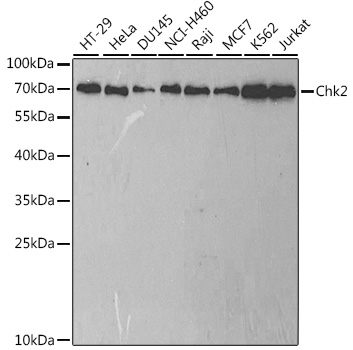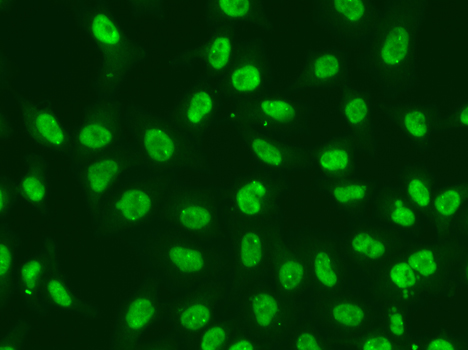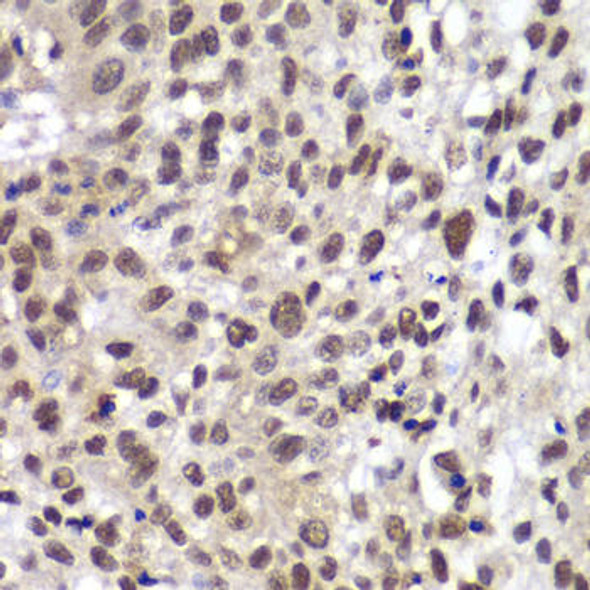Anti-Chk2 Antibody (CAB2145)
- SKU:
- CAB2145
- Product type:
- Antibody
- Reactivity:
- Human
- Host Species:
- Rabbit
- Isotype:
- IgG
- Research Area:
- Cell Death
Description
| Antibody Name: | Anti-Chk2 Antibody |
| Antibody SKU: | CAB2145 |
| Antibody Size: | 20uL, 50uL, 100uL |
| Application: | WB IF |
| Reactivity: | Human |
| Host Species: | Rabbit |
| Immunogen: | Recombinant fusion protein containing a sequence corresponding to amino acids 1-220 of human Chk2 (NP_009125.1). |
| Application: | WB IF |
| Recommended Dilution: | WB 1:500 - 1:2000 IF 1:50 - 1:200 |
| Reactivity: | Human |
| Positive Samples: | HT-29, HeLa, DU145, H460, Raji, MCF-7, K-562, Jurkat |
| Immunogen: | Recombinant fusion protein containing a sequence corresponding to amino acids 1-220 of human Chk2 (NP_009125.1). |
| Purification Method: | Affinity purification |
| Storage Buffer: | Store at -20°C. Avoid freeze / thaw cycles. Buffer: PBS with 0.02% sodium azide, 50% glycerol, pH7.3. |
| Isotype: | IgG |
| Sequence: | MSRE SDVE AQQS HGSS ACSQ PHGS VTQS QGSS SQSQ GISS SSTS TMPN SSQS SHSS SGTL SSLE TVST QELY SIPE DQEP EDQE PEEP TPAP WARL WALQ DGFA NLEC VNDN YWFG RDKS CEYC FDEP LLKR TDKY RTYS KKHF RIFR EVGP KNSY IAYI EDHS GNGT FVNT ELVG KGKR RPLN NNSE IALS LSRN KVFV FFDL TVDD QSVY PKAL RDEY |
| Gene ID: | 11200 |
| Uniprot: | O96017 |
| Cellular Location: | Nucleus, Nucleus, PML body, nucleoplasm |
| Calculated MW: | 15-38kDa/50-65kDa |
| Observed MW: | 70kDa |
| Synonyms: | CDS1, CHK2, HuCds1, LFS2, PP1425, RAD53, hCds1, CHEK2, Chk2 |
| Background: | In response to DNA damage and replication blocks, cell cycle progression is halted through the control of critical cell cycle regulators. The protein encoded by this gene is a cell cycle checkpoint regulator and putative tumor suppressor. It contains a forkhead-associated protein interaction domain essential for activation in response to DNA damage and is rapidly phosphorylated in response to replication blocks and DNA damage. When activated, the encoded protein is known to inhibit CDC25C phosphatase, preventing entry into mitosis, and has been shown to stabilize the tumor suppressor protein p53, leading to cell cycle arrest in G1. In addition, this protein interacts with and phosphorylates BRCA1, allowing BRCA1 to restore survival after DNA damage. Mutations in this gene have been linked with Li-Fraumeni syndrome, a highly penetrant familial cancer phenotype usually associated with inherited mutations in TP53. Also, mutations in this gene are thought to confer a predisposition to sarcomas, breast cancer, and brain tumors. This nuclear protein is a member of the CDS1 subfamily of serine/threonine protein kinases. Several transcript variants encoding different isoforms have been found for this gene. |
| UniProt Protein Function: | Chk2: a CAMK protein kinase of the Rad53 family. A cell cycle checkpoint regulator and putative tumor suppressor. It contains a forkhead-associated protein interaction domain essential for activation in response to DNA damage and is rapidly phosphorylated in response to replication blocks and DNA damage. Phosphorylates and inhibits CDC25C, preventing entry into mitosis, p53, leading to cell cycle arrest in G1, and BRCA1, restoring survival after DNA damage. Twelve splice variant isoforms have been described for human Chk2. LOF mutants cause Li-Fraumeni syndrome, a highly penetrant familial cancer phenotype also caused by p53 mutations. Familial mutations also associated with prostate and breast cancer, and mutations also seen in a variety of sporadic cancers and cell lines. |
| UniProt Protein Details: | Protein type:EC 2.7.11.1; Kinase, protein; Protein kinase, Ser/Thr (non-receptor); Protein kinase, CAMK; Tumor suppressor; CAMK group; RAD53 family Chromosomal Location of Human Ortholog: 22q12.1 Cellular Component: nucleoplasm; Golgi apparatus; PML body; chromosome, telomeric region Molecular Function:protein serine/threonine kinase activity; identical protein binding; protein binding; protein homodimerization activity; metal ion binding; ubiquitin protein ligase binding; protein kinase binding; ATP binding Biological Process: DNA damage induced protein phosphorylation; transcription, DNA-dependent; protein stabilization; protein amino acid autophosphorylation; positive regulation of transcription, DNA-dependent; DNA damage response, signal transduction; protein amino acid phosphorylation; regulation of transcription, DNA-dependent; DNA damage response, signal transduction resulting in induction of apoptosis; cell division; cellular protein catabolic process; double-strand break repair; DNA damage checkpoint; response to gamma radiation; regulation of protein catabolic process; G2/M transition of mitotic cell cycle; response to DNA damage stimulus Disease: Li-fraumeni Syndrome 2; Breast Cancer; Prostate Cancer; Osteogenic Sarcoma |
| NCBI Summary: | In response to DNA damage and replication blocks, cell cycle progression is halted through the control of critical cell cycle regulators. The protein encoded by this gene is a cell cycle checkpoint regulator and putative tumor suppressor. It contains a forkhead-associated protein interaction domain essential for activation in response to DNA damage and is rapidly phosphorylated in response to replication blocks and DNA damage. When activated, the encoded protein is known to inhibit CDC25C phosphatase, preventing entry into mitosis, and has been shown to stabilize the tumor suppressor protein p53, leading to cell cycle arrest in G1. In addition, this protein interacts with and phosphorylates BRCA1, allowing BRCA1 to restore survival after DNA damage. Mutations in this gene have been linked with Li-Fraumeni syndrome, a highly penetrant familial cancer phenotype usually associated with inherited mutations in TP53. Also, mutations in this gene are thought to confer a predisposition to sarcomas, breast cancer, and brain tumors. This nuclear protein is a member of the CDS1 subfamily of serine/threonine protein kinases. Several transcript variants encoding different isoforms have been found for this gene. [provided by RefSeq, Apr 2012] |
| UniProt Code: | O96017 |
| NCBI GenInfo Identifier: | 6685284 |
| NCBI Gene ID: | 11200 |
| NCBI Accession: | O96017.1 |
| UniProt Secondary Accession: | O96017,Q6QA03, Q6QA04, Q6QA05, Q6QA06, Q6QA07, Q6QA08 Q6QA10, A8K3Y9, B7ZBF3, B7ZBF4, B7ZBF5, |
| UniProt Related Accession: | O96017 |
| Molecular Weight: | 543 |
| NCBI Full Name: | Serine/threonine-protein kinase Chk2 |
| NCBI Synonym Full Names: | checkpoint kinase 2 |
| NCBI Official Symbol: | CHEK2 |
| NCBI Official Synonym Symbols: | CDS1; CHK2; LFS2; RAD53; hCds1; HuCds1; PP1425 |
| NCBI Protein Information: | serine/threonine-protein kinase Chk2; cds1 homolog; CHK2 checkpoint homolog; checkpoint-like protein CHK2 |
| UniProt Protein Name: | Serine/threonine-protein kinase Chk2 |
| UniProt Synonym Protein Names: | CHK2 checkpoint homolog; Cds1 homolog; Hucds1; hCds1; Checkpoint kinase 2 |
| Protein Family: | Serine/threonine-protein kinase |
| UniProt Gene Name: | CHEK2 |
| UniProt Entry Name: | CHK2_HUMAN |













